|
Walk On Into History
by Bob
Brooke
It’s 1883, and the
sounds of clip-clopping of horses hooves and the whirr of carriage
wheels fills the streets of a Mifflinburg, a small rural town in
central Pennsylvania. It’s a special day for William Heiss, who had
been working as an apprentice buggy maker with John Rischel, for he
is about to open his own buggy shop, the Heiss Coach Works, in the
carriage house behind his mother’s home on Green Street, with the
help of his mother and sister. It’s Heiss’ story that the
Mifflinburg Buggy Museum aims to tell.
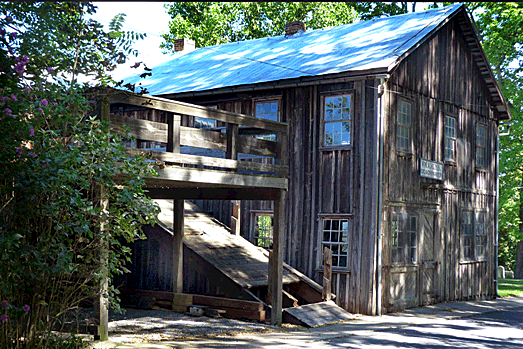
The Mifflinburg Buggy Museum is a sprawling complex, consisting of a
Visitor Center, the workshops of the Heiss Coach Works, a carriage
house, a repository or showroom, and the Heiss’ home, all a few
blocks off the main road through town.
The Heiss Coachworks
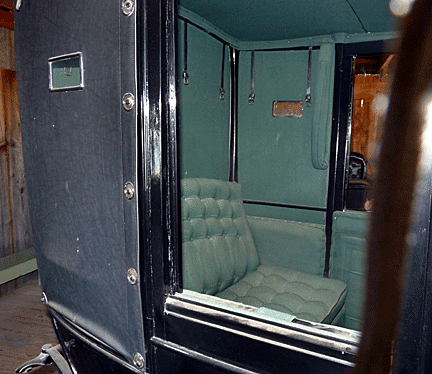 Heiss
had been in business for three years when he married Anna Smith in
1886 and she, too, joined him in the business, working as an
upholstery trimmer and seamstress. Heiss
had been in business for three years when he married Anna Smith in
1886 and she, too, joined him in the business, working as an
upholstery trimmer and seamstress.
Meanwhile, buggy maker Robert Weirick operated a workshop on Quarry
Road, a block behind the Heiss Coach Works. In 1889, Weirick sold
his workshop and property to Heiss. The first thing Heiss did was
add an L-shaped addition that included a carpentry shop, a paint
shop, assembly room, and a drying gallery.
Once he moved his buggy operation into Weirick’s former workshop,
Heiss used the carriage house for his buggy rental business. He
rented buggies with a horse for $1.50 per day. He also tried renting
bicycles and motorcycles. Unfortunately, the original building
burned in 1928 when Heiss left boiling wax unattended.
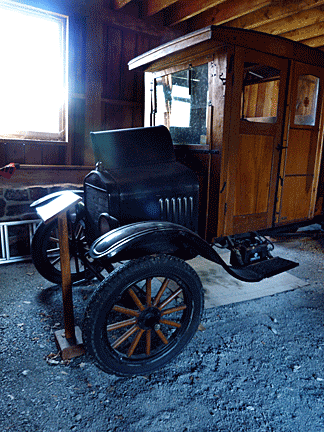 Dedicated
museum volunteer, Dr. Donald Mincemoyer supervised the
reconstruction of the carriage house in 1993. Masonry students of
the SUN Area Vocational-Technical School and the Agricultural
Studies students of the Mifflinburg Area High School built the
components which they then assembled in a barn raising during the
Buggy Days Festival. The building holds buggies and sleighs that
would have been typical of vehicles rented out by Heiss. Dedicated
museum volunteer, Dr. Donald Mincemoyer supervised the
reconstruction of the carriage house in 1993. Masonry students of
the SUN Area Vocational-Technical School and the Agricultural
Studies students of the Mifflinburg Area High School built the
components which they then assembled in a barn raising during the
Buggy Days Festival. The building holds buggies and sleighs that
would have been typical of vehicles rented out by Heiss.
Heiss employed 8 to 12 employees and operated for 42 years, one of
the longest operating buggy makers in town. They made only 50
buggies a year compared to up to 2,000 per year by other companies.
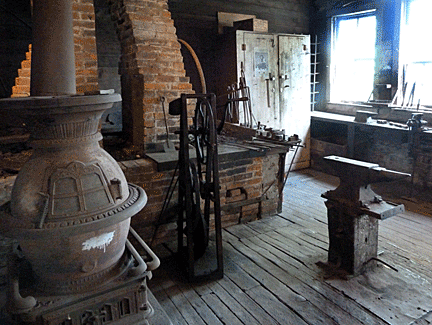 It
took two to three days to assemble a buggy. Tires came flat and had
to hammered in shape around the wheels. Unlike other carriages,
buggies had four wheels of equal size. Stuffing for seats consisted
of wood shavings or excelsior for lower-end models, horse hair for
middle-end models, and pigs hair for top-end models. A completed
Rockaway Buggy started at $150 for the base model. Extras cost more. It
took two to three days to assemble a buggy. Tires came flat and had
to hammered in shape around the wheels. Unlike other carriages,
buggies had four wheels of equal size. Stuffing for seats consisted
of wood shavings or excelsior for lower-end models, horse hair for
middle-end models, and pigs hair for top-end models. A completed
Rockaway Buggy started at $150 for the base model. Extras cost more.
 The
workshop was smelly and hot. Heiss paid his workers a $1 a day for 9
hours of work. All were men. Other companies paid their workers up
to $1.50 a day. Buggy companies in Philadelphia paid $2.25 for 6
hours work. As his business grew, he hired only men. His wife, by
that time, began working as a midwife. The
workshop was smelly and hot. Heiss paid his workers a $1 a day for 9
hours of work. All were men. Other companies paid their workers up
to $1.50 a day. Buggy companies in Philadelphia paid $2.25 for 6
hours work. As his business grew, he hired only men. His wife, by
that time, began working as a midwife.
To keep soot from getting into the upstairs paint shop, Heiss
wrapped the joices above his workshop with wallpaper. Workers wet
down the floor each morning to keep the dust down.
The Paintshop
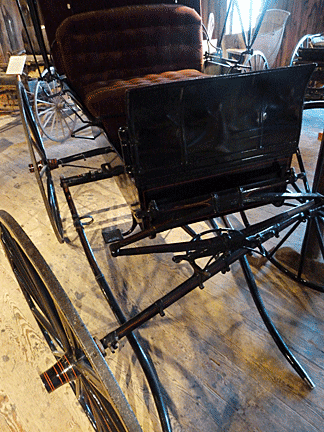 Heiss
took great pride in the painting of his buggies. It was how he
separated himself from his competition. Painters, working on the
second floor of the workshop, were the highest paid and most skilled
employees in Heiss’ buggy factory. While workers could assemble a
buggy in two to three days, painting one required 9 to 12 days.
Buggies received 9 to 12 coats of paint, some as many as 15.
Painters applied each coat by hand using a brush, and each coat
required a full day of drying time. Between each coat, paint shop
workers wet sanded the pieces with pumice soap. Then they gave each
buggy a final two coats of clear varnish to give it a high shine. To
keep their buggies’ finishes in top condition, owners would bring
their vehicles to Heiss every few years to have the varnish
reapplied. Fire was always a hazard, so Heiss closed his workshop
for two months in winter because he couldn’t have a wood or coal
stove burning in the same building as the paint shop. Heiss
took great pride in the painting of his buggies. It was how he
separated himself from his competition. Painters, working on the
second floor of the workshop, were the highest paid and most skilled
employees in Heiss’ buggy factory. While workers could assemble a
buggy in two to three days, painting one required 9 to 12 days.
Buggies received 9 to 12 coats of paint, some as many as 15.
Painters applied each coat by hand using a brush, and each coat
required a full day of drying time. Between each coat, paint shop
workers wet sanded the pieces with pumice soap. Then they gave each
buggy a final two coats of clear varnish to give it a high shine. To
keep their buggies’ finishes in top condition, owners would bring
their vehicles to Heiss every few years to have the varnish
reapplied. Fire was always a hazard, so Heiss closed his workshop
for two months in winter because he couldn’t have a wood or coal
stove burning in the same building as the paint shop.
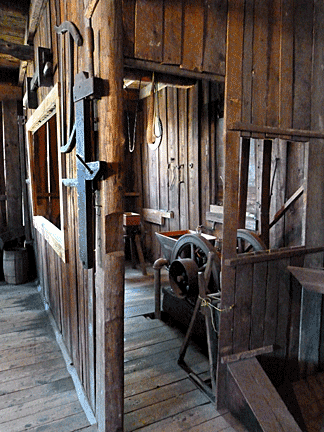 Heiss
modernized his shop in 1915 by installing a line shaft and a
gasoline powered hit and miss engine produced by New Holland in
1910. In 1917, Heiss’ company began making wooden car, truck, and
bus bodies. He saw the writing on the wall as automobiles began to
replace horse-drawn vehicles. Heiss
modernized his shop in 1915 by installing a line shaft and a
gasoline powered hit and miss engine produced by New Holland in
1910. In 1917, Heiss’ company began making wooden car, truck, and
bus bodies. He saw the writing on the wall as automobiles began to
replace horse-drawn vehicles.
The Repository
In 1895, when Heiss’ buggy business was at its peak, he had a
showroom built across the street from his factory. He paid two men,
two buggies to build the three-story structure. He used the ground
and third floors for storage and the second or main floor as the
buggy showroom. When his business declined after the turn of the
century, Heiss rented it to another buggy maker. From 1908 to 1928,
he rented the building to an Athletic Club and a hardware salesman.
He even let the local Boy Scout troop use it for their meetings.
Prior to his death, Heiss began to transform his showroom, or
repository as he called it, into an apartment house, but no one ever
lived there. The building now houses a Conestoga wagon, a mail
wagon, a racing sulky, a democrat, and other horse-drawn vehicles.
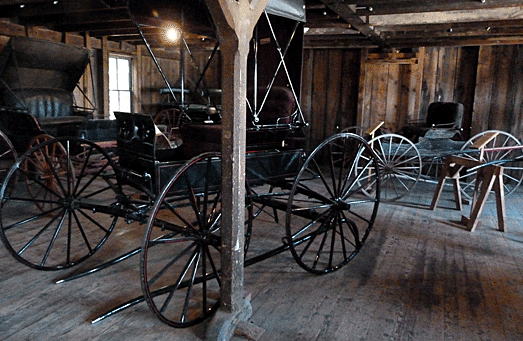
As the demand for
automobiles grew, the demand for buggies declined. To offset his
declining income, Heiss tried doing other things, including
repainting automobiles, selling stoves, “Can’t Sag” fence gates, and
Valentine’s paints and varnishes. He also made and repaired
furniture, sold lumber, baling twine and oil, and even tried his
hand at beekeeping. His wife, Anna, also helped bring in income by
working as a midwife in the neighborhood, selling women’s hygiene
products, and taking in boarders.
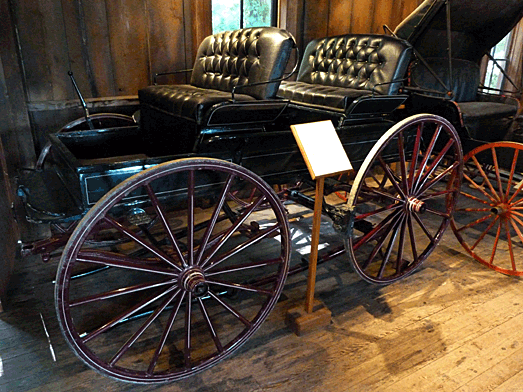
Heiss Coach Works became known for its fine quality buggies and sold
them to buyers from Pennsylvania and beyond. The buggy works closed
upon Heiss’ death in 1931. For years, the buildings and their
contents lay undisturbed—until four decades later.
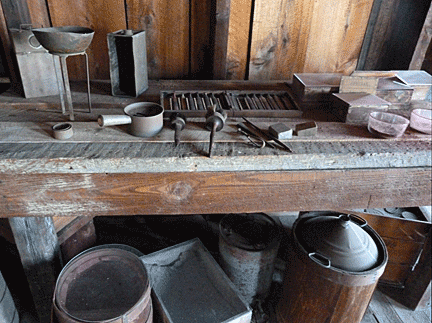 Behind
the closed doors of the factory lay 40 years of buggy making
history. Heiss’ tools, horseshoes, tires, wheels, dashboards,
upholstered seats, paints, catalogs for parts, and his own account
books lay where he had left them. Finished buggies in ruins and
vehicles barely begun lay scattered about. Among the tools and buggy
parts were beehives, honey can labels, farm tools and more. The shop
was virtually intact from its original use. It was as if William
Heiss had closed the doors after a day of work intending to return
the next morning. Behind
the closed doors of the factory lay 40 years of buggy making
history. Heiss’ tools, horseshoes, tires, wheels, dashboards,
upholstered seats, paints, catalogs for parts, and his own account
books lay where he had left them. Finished buggies in ruins and
vehicles barely begun lay scattered about. Among the tools and buggy
parts were beehives, honey can labels, farm tools and more. The shop
was virtually intact from its original use. It was as if William
Heiss had closed the doors after a day of work intending to return
the next morning.
Today, the buggy making workshop is practically as it was when Heiss
and his workers made buggies there. To walk through it is like
taking a step back in time.
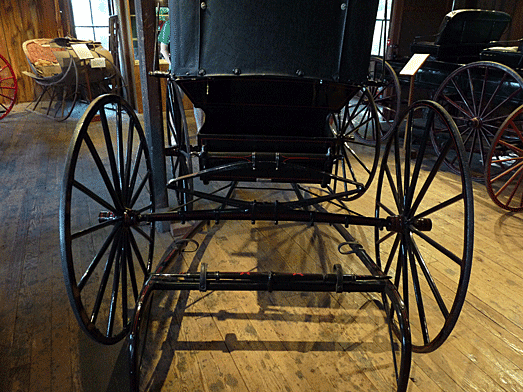
At the peak of production, twenty Mifflinburg companies each
produced over 5,000 buggies annually, thus giving the town the
nickname “Buggy Town.” Every business in town served the needs of
the buggy makers. Over time, ninety different companies made buggies
and carriages in Mifflinburg.
The Heiss Family Home
The Heiss home, located along Green Street behind the coach works
and across the street from the Visitor Center, is a modest two-story
affair with five bedrooms. The Heiss family rented some of the
bedrooms out to their workers. They charged $5 to $15 for room and
board, the equivalent of a third of a month’s salary, with laundry
extra. Boarders shared rooms. Heiss’ wife, Anna, joined the family
buggy making business as a trimmer or seamstress shortly after their
marriage in September of 1896. She also worked as a midwife.
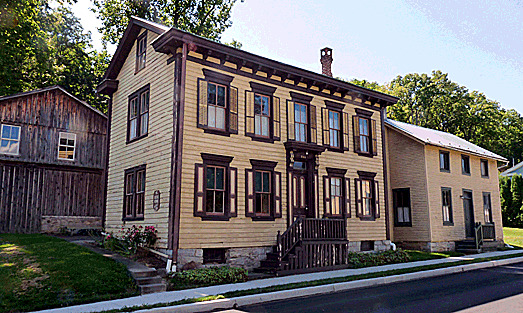
Visitors first enter the small formal parlor with its adjacent
kitchen. The front room shows that the Heiss family had varied
interests. Anna was an organist for the church she and her husband
helped to start. Her pump organ, on which she practiced, sits in one
corner of the parlor. Her secretary, where she kept household
records and wrote to her family and friends sits on the opposite
wall.
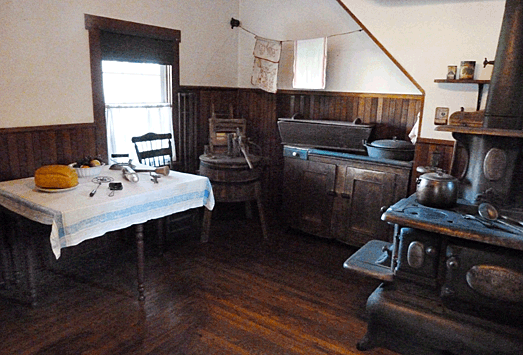
 Anna
Heiss had all the modern conveniences in her kitchen. She wanted an
icebox, but her husband thought Sears Roebuck charged too much, so
he made one himself. Besides an icebox, she also had a 1915 cook
stove with a water tank, and a clothes washing machine. In 1898, the
Heisses added running water which cost $6 a year. They added
electricity in 1903 and in 1918 they added new flooring on the first
floor. In 1920, they converted one of the children’s bedrooms into a
bathroom. Anna
Heiss had all the modern conveniences in her kitchen. She wanted an
icebox, but her husband thought Sears Roebuck charged too much, so
he made one himself. Besides an icebox, she also had a 1915 cook
stove with a water tank, and a clothes washing machine. In 1898, the
Heisses added running water which cost $6 a year. They added
electricity in 1903 and in 1918 they added new flooring on the first
floor. In 1920, they converted one of the children’s bedrooms into a
bathroom.
The Heisses purchased their oak rope bedroom suite from a local
store in 1911. A quilt, made in 1832 by Christine Pontis, covers
their bed. The brown fabric used to make it came from Anna’s wedding
dress. It’s believed to be the oldest quilt in the country.
Mifflinburg Today
Today, Mifflinburg sits quietly off the main road, its streets
relatively silent. The homes of the buggy makers have been lovingly
restored, giving the town an old-fashioned charm.
The museum is one of only a dozen craft/industrial museums in the
country that preserves and interprets an original site. Visitors can
walk through the various workshops, view buggies in various stages
of construction and on special occasions, experience the equipment
in operation.
The Mifflinburg Buggy Museum complex is open from April through
October from Thursdays through Saturdays from 10 A.M. to 5 P.M. and
on Sundays from 1 to 5 P.M. You must take a tour to see the
interiors of the buildings. The last tour begins no later than 4
P.M.
For more information, visit the
Mifflinburg Buggy Museum Web
site.
<
Back to More Antiques to View
Next Article > |
